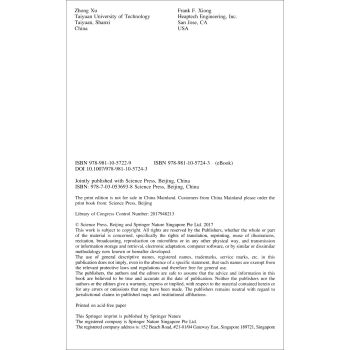内容简介:
This book provides a comprehensive introduction to and technical description of a unique patented surface-modification technology: plasma surface metallurgy with double- glow discharge plasma process, known as the Xu-Tec process. As such it promotes further attention and interest in scientific research and engineering development in this area, as well as industrial utilization and product commercialization.The Xu-Tec process has opened up a new material engineering field of "Plasma Surface Metallurgy". This surface-modiFication process can transform many low-grade and low-cost industrial engineering materials into "gold" materials with a high value and high grade or special functions. This improved material can be widely used in industrial production to improve the surface performance and quality of mechanical parts and manufacturing products, and to conserve expensive alloying elements for the ben efit of all mankind.
"This book will be valuable to those in the general area of surface metallurgy. The substantial description of the Xu-Tec process is very important and should assist in expanding the use of this superior technique. The in-depth explanation of glow discharges and their use in general will also serve as a valuable reference in the field."
目录:
Contents
1 Introduction 1
1.1 Engineering Materials and Its Surface 1
1.2 Surface Engineering and Its Classification 2
1.2.1 Concept of Surface Engineering 2
1.2.2 Surface Hardening Technology 3
1.2.3 Surface Covering Technology 4
1.2.4 Surface Alloying/Metallurgy Technology 5
1.2.5 Classification Table 6
1.3 Existing Surface Alloying Technology 7
1.3.1 Conventional Surface Alloying Technology 7
1.3.2 Modern Surface Alloying Technology 8
1.3.3 Concept of Plasma Surface Metallurgy 8
1.4 Glow Discharge and Plasma Nitriding 9
1.4.1 History of Glow Discharge 9
1.4.2 Concept of Plasma 10
1.4.3 Advent of Plasma Nitriding in Germany 10
References 11
2 Plasma Nitriding 13
2.1 Glow Discharge and Its Characteristics 13
2.1.1 Characteristics of Glow Discharge 13
2.1.2 Stratified Phenomenon 14
2.1.3 Interactions Between Ions and Material Surface 15
2.2 Plasma Nitriding Process 17
2.2.1 Basic Principle 17
2.2.2 Advantages 18
2.2.3 Industrial Applications 18
2.3 Other Plasma Surface Alloying Technology 19
2.3.1 Plasma Carburizing 19
2.3.2 Plasma Nitro-Carburizing 19
2.3.3 Plasma Sulphurizing 19
2.4 Restriction of Plasma Nitriding 20
2.5 Development of Plasma Nitriding in China 20
References 21
3 Double Glow Discharge Phenomenon and Its Applications 23
3.1 What Is Double Glow Discharge Phenomenon? 23
3.2 Discovery of Double Glow Discharge 24
3.3 Double Glow Discharge Modes 25
3.3.1 Independent Discharge Mode 25
3.3.2 Dependent Discharge Mode 25
3.3.3 Pulse Discharge Mode 26
3.3.4 Other Discharge Mode 26
3.4 Double Glow Hollow Cathode Discharge (DG-HCD) 26
3.4.1 Hollow Cathode Discharge (HCD) 26
3.4.2 Concept of DG-HCD 28
3.4.3 Current Amplification Effect of DG-HCD 29
3.5 Advent of Double Glow Plasma Surface Alloying/Metallurgy(Xu-Tec Process) 30
3.5.1 First Experimental Device 30
3.5.2 First Microstructure of Tungsten Surface Alloy 31
3.5.3 Other Considerations 32
References 32
4 Double Glow Plasma Surface Alloying/Metallurgy Technology 33
4.1 Introduction 33
4.2 Basic Principle 34
4.3 Diffusion Mechanism 36
4.4 Process Operation 37
4.5 Configuration of Working-Piece and Source Electrode 38
4.5.1 Plate Type 38
4.5.2 Cave Type 39
4.5.3 Deep Well Type 40
4.6 Technological Parameters 40
4.6.1 Measurable Parameters 40
4.6.2 Typical Process Parameters 47
4.6.3 Nonmeasurable Parameters 48
4.7 Arc Discharge 49
4.7.1 Micro-Arc Discharge 50
4.7.2 Macro Arc Discharge 50
4.7.3 Harmfulness of Arc Discharge 51
4.7.4 Reasons of Arc Discharge 51
4.8 Cathode Power Transmission Device and Gap Protection 53
4.8.1 Requirements of Cathode Transmission Device 54
4.8.2 Principle of Gap Protection 54
4.8.3 Example of Cathode Transmission Device 56
4.9 Advantages of Xu-Tec Process 56
4.10 Requirements for Operators 58
4.11 Xu-Tec Process in USA 58
4.12 Xu-Tec Process in China 59
4.13 Summary and Outlook 60
References 61
5 Physical Basis of Plasma Surface Metallurgy 63
5.1 Glow Discharge and its Discharge Characteristics 63
5.1.1 Gas Discharge 64
5.1.2 Glow Discharge Process 64
5.1.3 Stratification Phenomenon 66
5.1.4 Glow Discharge Characteristics 68
5.2 Low-Temperature Plasma 69
5.2.1 Plasma and Its Generation 69
5.2.2 Characteristics of Double Glow Discharge Plasma 71
5.3 Ion Bombardment and Sputtering 73
5.3.1 General Description of Sputtering Process 73
5.3.2 Preferential Sputtering 75
5.3.3 Alloy Sputtering 75
5.4 Propagation of Glow Discharges 76
5.4.1 Ionization Degree and Mean Free Path 77
5.4.2 Propagation of Plasma in Double Glow Discharges 78
5.5 Diffusion Process Under Ion Bombardment 79
5.5.1 Diffusion Model 80
5.5.2 Diffusion Mechanism 82
5.6 Prospect 85
References 87
6 Plasma Surface Metallurgy of Iron and Steel 89
6.1 Introduction 89
6.1.1 Plasma Surface Alloying and Alloying Element 89
6.1.2 Interaction of Alloying Element with Fe and C 90
6.2 Single-Element Plasma Surface Metallurgy 91
6.2.1 Plasma Surface W Alloying 91
6.2.2 Plasma Surface Ti Alloying 92
6.2.3 Plasma Surface Cr Alloying 93
6.2.4 Plasma Surface Al Alloying 95
6.2.5 Plasma Surface Mo Alloying 95
6.2.6 Plasma Surface Ta Alloying 97
6.3 Multiple-Element Plasma Surface Metallurgy 97
6.3.1 Plasma Surface W-Mo Alloying 98
6.3.2 Plasma Surface Ni-Cr Alloying 99
6.3.3 Plasma Surface Cr-Mo Alloying 99
6.4 Plasma Surface Metallurgy Superalloys 100
6.4.1 Superalloy 100
6.4.2 Plasma Surface Ni-Cr-Mo-Nb Superalloys 101
6.4.3 Plasma Surface Ni-Cr-Mo-Cu Superalloys 102
6.5 Plasma Surface Metallurgy Precipitation Hardening
Stainless Steels 103
6.5.1 Plasma Surface Alloying Process 103
6.5.2 Age Hardening Process 104
6.5.3 Corrosion and Wear Tests 104
6.6 Plasma Surface Metallurgy Antibacterial Stainless Steels





好评度